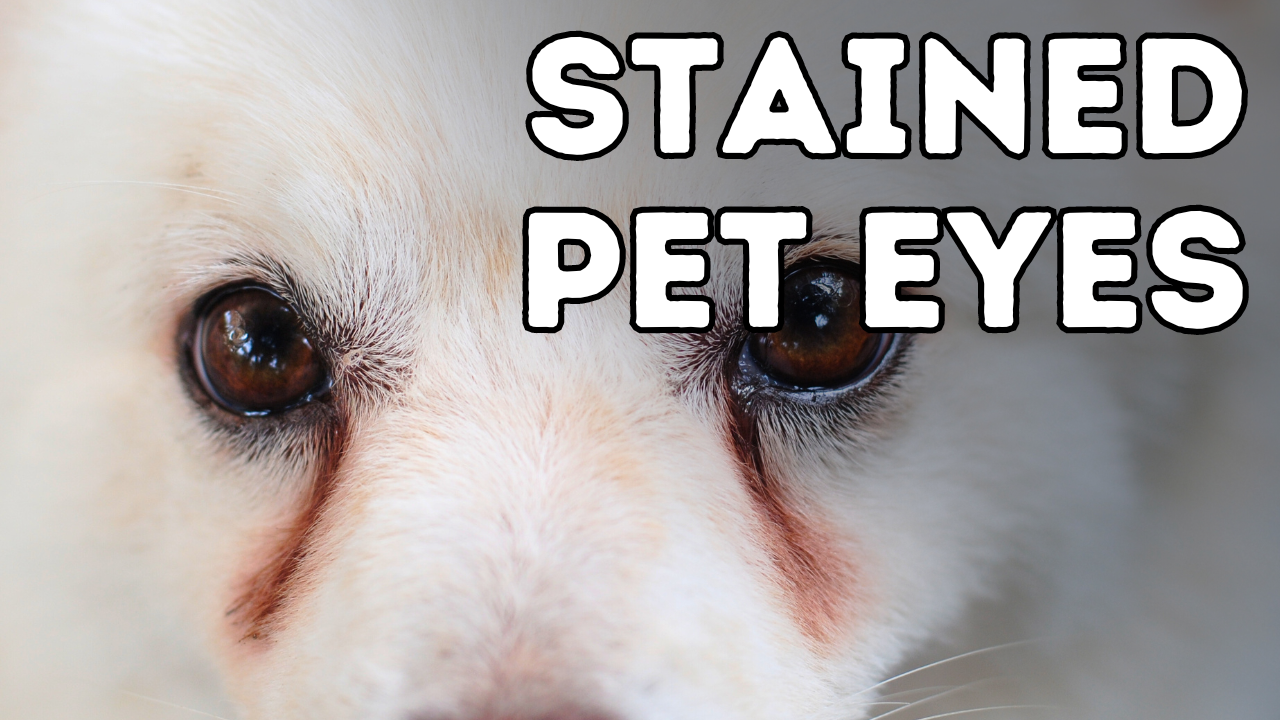How to Treat Tear Stains in Dogs and Cats: Safe & Effective Solutions

Runny eyes in our dogs and cats is surprisingly common – My dog Tula and my last cat Murray both had this problem.
Most often it’s associated with partially blocked tear ducts, and one of the keys is to decrease duct inflammation.
Our Omega 3 supplement may help… .
Dr. Jones’ Ultimate Omega 3 Formula for Dogs and Cats is 100% natural, full spectrum, organic Antarctic Krill Oil, rich in EPA, DHA, Phospholipids and Astaxanthin.
Guaranteed to be naturally preserved and toxin – free:



Tear staining refers to the reddish-brown discoloration found on the hair under the eyes of dogs and cats. It is most commonly seen in small breed dogs and can also occur in cats, particularly noticeable in animals with white fur.
Causes of Tear Staining
The primary cause of tear staining is excessive tear production, known as epiphora. This constant wetness under the eyes leads to staining. Several factors contribute to excessive tearing:
- Medical issues such as ingrown eyelashes, eye infections, abnormal tear glands or ducts, glaucoma, entropion, ear infections, dental problems, systemic issues, and certain medications.
- Environmental and lifestyle factors like stress, hormonal changes, humidity, smog, allergens, irritants, second-hand smoke, and the type of food or water bowls used.
Porphyrins and Yeast
Tear stains are predominantly caused by porphyrins, iron-containing molecules produced during the breakdown of red blood cells. These molecules, excreted through tears, can stain the fur when left sitting. Additionally, red yeast (Pityrosporum), which thrives in moist conditions, can exacerbate staining and produce a noticeable odor.
Veterinary Consultation
It is crucial to consult a veterinarian or an ophthalmologist to rule out any underlying medical causes of excessive tearing before attempting any treatments.
Home Remedies and Prevention
- Keeping the Area Dry: Regularly clean and dry the facial hair, avoiding commercial liquid products that may keep the area moist.
- Dietary Changes: Consider a hypoallergenic food trial for six weeks to rule out food allergies.
- Good Bacteria: Adding probiotics can help, as there is a link between excess tear production, inflammation, and bacterial/yeast growth.
- Water and Food Bowls: Opt for glass or stainless steel dishes to prevent bacteria buildup. Using water bottles can help keep the face dry.
- Hair Management: Keep the hair around the eyes trimmed to prevent tears from wicking down.
- Eye Flushing: Daily flushing with a boric acid eyewash can be beneficial.
- Air Quality: Use an air purifier to reduce airborne allergens.
- Tear Duct Maintenance: If tear ducts are blocked, a vet may flush them, though this may be a temporary solution.
Recipe for Reducing Tear Staining
A homemade remedy involves mixing a pinch of cornstarch with boric acid powder and applying it to the wet fur to help dry and lighten the stained area.
When to Consider Antibiotics
If other methods fail, a course of antibiotics, such as Tylan (tylosin), might be considered. However, this should be done under veterinary supervision and is not effective for all dogs.
Managing tear staining can be frustrating, but with diligence, many cases can be controlled without resorting to antibiotics. For additional support, consider supplements like Dr. Jones’ New Krill Oil Supplement to help decrease inflammation related to various conditions, including tear staining.
Dr. Jones’ New Krill Oil Supplement

Hi Dr.Jones
My dog Cuddles eye run and stain on her white and black fur. I give her two pills of omega 3 krill oil. Under her chin is red and rolls in grass constantly every time we go on a walk. What can I do? Oh Cuddles is 40 to 50 pounds
Then my black and white chihuahua eyes same way and since i had him he walks and then hops on his black legs alternating from right to left then he stops and walks normal what can I give him. Thank you for your supplements and videos you are a God sent. Thank God for you.
Here’s an article that will help your pet:
Runny eyes in our dogs and cats is surprisingly common – My dog Tula and my last cat Murray both had this problem.
Most often it’s associated with partially blocked tear ducts, and one of the keys is to decrease duct inflammation.
Our Omega 3 supplement may help.
Tear Staining in Dogs and Cats
Tear staining is the reddish brown discoloration that is found on the hair under the eyes. It occurs most commonly in small breed dogs, but it is also seen in cats. It is most visible in animals with white fur.
Tear staining is caused by excessive tear production (epiphora). The hair under the eyes is constantly wet and this can lead to it staining.
One interesting fact is if there is no excessive tearing, there will be no tear staining. It’s also not unusual to have littermates—one who stains and one who doesn’t. Genetics does play a role in tear staining.
First and foremost, it is very important to see your vet or ophthalmologist first to rule out any medical causes for excessive tearing.
Some medical causes include: ingrown eyelashes, infection of the eye, unusually large tear glands, unusually small or blocked tear ducts, glaucoma, entropion (inverted eyelid), large prominent eyes, ear infection, dental issues, some kind of systemic issue and certain medications.
There are other elements that can cause excessive tearing: stress, hormonal changes, higher humidity, smog, high winds, allergens, irritants, second hand smoke, plastic food/water bowls, high mineral content of water, allergies, type of food fed, hair in the eyes and teething.
Tear stains are usually the result of porphyrins. Porphyrins are iron containing molecules that are produced when the body breaks down red blood cells. Some of these porphyrins are excreted through tears, saliva and the pads of the feet.
When tears containing porphyrins sit on the hair for any period of time, staining will occur. And yes, the iron related stains will darken if exposed to sunlight.
Besides porphyrins, red yeast (Pityrosporum) can also contribute to tear staining. Yeast loves moist areas, so wet hair under the eyes would certainly be favourable for it to flourish. Yeast infection under the eyes will have a noticeable odour.
It is quite possible for a dog/cat to have both porphyrins and yeast at the same time.
To add to the confusion, bacteria seem to be involved somehow. The mechanism of bacteria is not well understood. What is clear is that some dogs who are given certain antibiotics will result in the tear staining clearing up.
So what to do?
Once the vet has ruled out any medical issues, there are a number of things you can try to reduce the staining:
Keep the facial hair clean and dry.This may require tending to the wet area 2-3 times a day. Avoid using commercial liquid products. You want to keep the area dry, not wet.
Use a flea comb to remove any eye debris and blot with a tissue.
Tear Staining RECIPE
A favourite recipe is to take a pinch of half cornstarch/half boric acid powder and work it into the wet hair with your fingers, then leave it. The cornstarch helps dry the area while the boric acid will gradually lighten the staining. If you do this diligently every day, usually within a month, you can see a noticeable change.
Diet change:There may be an underlying food allergy that is contributing to this. Consider a 6 week hypoallergenic food trial.
Good Bacteria. Many pet parents are finding adding in probiotics to be beneficial as there appears to be a link between excess tear production, inflammation, and the bodies ability to fight the resulting bacteria/yeast. We have had many people say that Ultimate Canine and Ultimate Feline have helped.
The food and water bowls. Use glass or stainless steel food dishes. Plastic dishes can harbour bacteria. Many breeders use “water bottles” to help keep the faces dry.
Keep the hair short: For pets, trim the hair at the corner of the eyes. It helps prevent the tears from “wicking” down the moustache.
EYE FLUSHING.For some, flushing the eyes daily with an eyewash containing boric acid eg. Collyrium can help
DECREASE Air ALLERGENS: Consider and air purifier and this has helped some pets.
FLUSHING the DUCTS:If the tear ducts are plugged, your vet might be able to flush them out. Be aware however, that this is often a temporary measure, as the ducts often plug up again with time.
About Antibiotics…
Last but not least is going the antibiotic route. This is something that should not be taken lightly.
If all of the above has failed, then perhaps trying a course of antibiotics might be worth looking into. You and your vet will have to work together on to figure out the correct dosage and for how long.
Tylan (tylosin) seems to be the drug of choice these days.
Antibiotics for tear staining doesn’t work on all dogs, so if the staining isn’t clearing up after a reasonable length of time, don’t continue using it.
Hi, I have 4 poodles and they get the stains. What do you mean by water bottles for water. I would spill water all over if I use regular water bottles. Maybe you mean something else. Please help me.